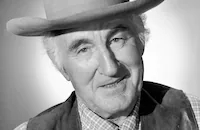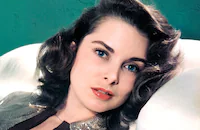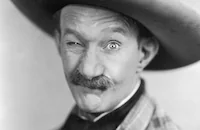Hills of Home

Brief Synopsis
Cast & Crew
Fred M. Wilcox
Edmund Gwenn
Donald Crisp
Tom Drake
Janet Leigh
Rhys Williams
Film Details
Technical Specs

Synopsis
In the small Scottish mountain town of Glen Urtach, shepherd Mr. Milton nearly drowns his sheep-tending collie dog Lassie while punishing her for not performing her duties properly. With no further need for Lassie, Milton gives her to Dr. William MacLure in exchange for another dog. While negotiating the trade, Milton learns that his son Tammas has been secretly apprenticing with William in the hope of someday becoming a doctor. Angered by the discovery, Milton criticizes his son for refusing to become a farmer. Later, while crossing a shallow river, William discovers that Lassie suffers from an inexplicable fear of water. Realizing that Lassie will be a poor sheep herder, William sells her to a dog trainer at the Kildrummie Fair. A short time later, when William finds out that the dog trainer is using cruel training methods, he buys Lassie back. While traveling through a snow storm to visit Saunders, an ailing patient in another town, William approaches a storm-damaged bridge, and realizes that the only way he can cross is without the added weight of his medical supplies. With help from Lassie, who carries the supplies on her back, William crosses the bridge successfully and arrives safely at Saunders' place. After treating Saunders, William discovers that Tammas has fallen ill with appendicitis. As Tammas' condition worsens, William decides to use chloroform, an untested anesthetic, to perform an operation on him. Before administering the chloroform to Tammas, William tests it on Lassie. Following the successful operation, William persuades Mr. Milton to allow Tammas to study medicine at Edinburgh. After bidding farewell to his sweetheart, Margit Mitchell, Tammas leaves for the university. Years pass, and one day, while crossing through the country in a storm, William suffers an injury. Lassie, having finally overcome her fear of water, brings help to William, but the doctor dies a short time later. Tammas, now a doctor, returns to Glen Urtach for William's funeral, and after being reunited with Margit, agrees to take over William's job.

Director

Fred M. Wilcox
Cast

Edmund Gwenn

Donald Crisp

Tom Drake

Janet Leigh

Rhys Williams

Reginald Owen
Edmond Breon

Alan Napier
Hugh Green
Lumsden Hare
Eileen Erskine
Victor Wood
David Thursby
Frederick Worlock
Lassie

Holmes Herbert

Douglas Walton
Cyril Smith

Phyllis Morris
Mary Gordon
Trevor Bardette
James Wethered
Richard Glynn
Henry Blair
Frank Austin
James Beck
Warwick Gregson
Roy Butler

Queenie Leonard
Paul England
Tom Dillon
Robert Hale
James Logan
Gerald Rogers
John Power
Pat O'moore
James Fairfax
David Dunbar
George Kirby
Alec Harford
Harry Wilson
Ray Saunders
Walter Cook
Russ Saunders

Billy Curtis
Ed Wolff
Jolly Lee Dowlen
Louis Manley
Opal Manley
Harry Johnson
Duke Johnson
Fred Johnson
Eldon Gorst
Sally Shepherd
Rita Quigley
Campbell Copelin

James Finlayson
Jim Fowler
Pietro Sosso

Sylvia Andrew
Sybil Bacon
Crew
Paul G. Chamberlain
Jack Dawn
Robert Franklyn
Cedric Gibbons
Sydney Guilaroff
Eddie Imazu
Henri Jaffa
Natalie Kalmus
William Ludwig
Earl Mcevoy
Warren Newcombe
Charles Schoenbaum
Albert Sendrey
Douglas Shearer
Robert Sisk
Herbert Stothart
Valles
Edwin B. Willis
Ralph E. Winters

Photo Collections
Videos
Trailer
Hosted Intro




Film Details
Technical Specs

Articles
Hills of Home
Lassie Come Home was such a hit that six more Lassie movies followed, all of them starring Pal, who had by then assumed the stage name and persona of Lassie, and had become one of MGM's top stars. By 1946, he even had his own radio show. Like many stars, he proved his versatility by playing other characters. The first sequel, in fact, was called Son of Lassie (1945), and he actually played a male - Laddie, the eponymous son. But in all the sequels, and whatever the name, the dog's character was always the same: handsome, dignified, brave, smart, and resourceful. "Greer Garson with fur," one critic called him.
Hills of Home (1948), the fourth Lassie film, reunited Pal with Edmund Gwenn and Donald Crisp, who had appeared in Lassie Come Home. Gwenn plays an old Scottish doctor who saves the female dog from a cruel master. The dog in the story is afraid of water, and the doctor tries to cure her of her phobia. Since Pal was an excellent swimmer, it took all his acting skills and Weatherwax's training expertise not only to put across the character's water phobia, but to show the dog conquering her fear in order to rescue Gwenn.
Hills of Home was the final Lassie movie directed by Fred Wilcox, who had made his directing debut with the original Lassie Come Home, and also helmed Courage of Lassie (1946), starring Elizabeth Taylor. Wilcox may have been good with kids and animals, but according to co-star Janet Leigh, he wasn't much help to adult actors, especially inexperienced ones like herself. Hills of Home was Leigh's third film, and her second in which the California-born actress had to do an accent - she plays a Scottish girl. In her autobiography, Leigh recalled that her acting coach took extra time preparing her. And when Leigh began work on the film and met Wilcox, she realized why. Wilcox, Leigh recalled, "was a very nice man but an extremely weak director. An actor was really left on his own." Thanks to her acting coach's training, Leigh wrote, "I managed to squeak by without making a fool of myself." Wilcox made only a few more films, competently directing child stars in The Secret Garden (1949) and a robot in the cult favorite, Forbidden Planet (1956).
After appearing in three more Lassie films in the late 1940s and early 1950s, Pal starred in the pilot for the Lassie television series, before turning over the Lassie role to his son, Lassie, Jr. All the subsequent Lassies on television and film have been played by descendants of Pal. And all have been trained by members of the Weatherwax family: Rudd, his brother Frank, and Rudd's son, Robert. After many years of success on television, Lassie even made a movie comeback, in The Magic of Lassie (1978), co-starring James Stewart and Mickey Rooney. Neither that film, nor another version, Lassie (1994), were able to recapture the magic of the earlier films. Yet another remake, based on the original Eric Knight novel, began production in Ireland in April 2005, under the direction of Charles Sturridge.
Director: Fred M. Wilcox
Producer: Robert Sisk
Screenplay: William Ludwig, based on Ian Maclaren's sketches, "Doctor of the Old School"
Cinematography: Charles Schoenbaum
Editor: Ralph E. Winters
Costume Design: Valles
Art Direction: Cedric Gibbons, Eddie Imazu
Music: Herbert Stothart
Principal Cast: Pal (Lassie), Edmund Gwenn (Dr. William McLure), Donald Crisp (Drumsheugh), Tom Drake (Tammas Milton), Janet Leigh (Margit Mitchell), Rhys Williams (Mr. Milton), Reginald Owen (Hopps), Alan Napier (Sir George).
C-97m. Closed captioning.
by Margarita Landazuri

Hills of Home
Quotes
Trivia
Notes
An August 1947 Hollywood Reporter news item noted that scenes depicting the Scottish Highlands were shot at the Sonora Pass in the Sierra mountains of Northern California. Working titles for this film were Danger in the Hills and Master of Lassie. Ian MacLaren's story was previously filmed in 1921 under the title The Bonnie Briar Bush. That film, a Paramount release, was directed by and starred Donald Crisp (see AFI Catalog of Feature Films, 1921-30; F2.0514). For more information on the "Lassie," series see the entry below for Lassie Come Home and consult the Series Index.

Miscellaneous Notes
Released in United States Winter December 1948
Released in United States Winter December 1948














